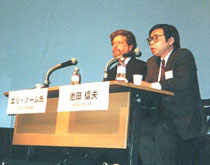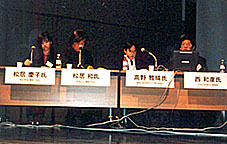WWVi International Symposium: Communication and Broadcasting in the Age of Internet 2001
Session 1: Television in the Broadband Age
Keynote speaker:
Eli M. NOAM (Professor, Columbia University)
Panelists:
Kazuhiko NISHI (Visiting Professor, MIT), Masaharu TAKANO (President, Bitmedia Inc.), Kazu MATSUI (Music Producer), Keiko MATSUI (Pianist)
Coordinator:
Nobuo IKEDA (Professor, GLOCOM)
Discussion Summary:
 IKEDA (Professor, GLOCOM): Thank you very much Dr. Noam. We would like to have comments from each of the panelists. First, Mr. Kazuhiko Nishi, the vice-chairman of ASCII and a visiting professor at MIT, is a pioneer in this field. IKEDA (Professor, GLOCOM): Thank you very much Dr. Noam. We would like to have comments from each of the panelists. First, Mr. Kazuhiko Nishi, the vice-chairman of ASCII and a visiting professor at MIT, is a pioneer in this field.
NISHI (Visiting Professor, MIT): I would like to think more about Dr. Noam's point that Japan is strong in networked appliances and also about multi-media contents in the age of broadband Internet.
As telecommunications and the Internet are merging and as the Internet and broadcasting are merging, we should be aware of the difference between the Internet, which is a pull medium, and broadcasting, which is a push medium in essence. In this context, an important development, I think, would be not only the merger of TV broadcasting and websites, but also the merger of Internet portal sites and electronic program guides. Program guides for digital broadcasting and websites such as Infoseek or Yahoo will probably have the same user interface. This may be ideal for videotaping some future programs, but the question is how to deal with past programs that we cannot videotape ex post. Here, VOD (video on demand) will come in. So I think the most likely development will be digital video recorders with electronic program guides and Internet-based VOD.
As for contents, animation, music, movies and others, which are currently provided in the form of DVD packages, will be gradually taking the form of VOD. Also, news with audience feedback, games on-line, as well as advertisement contents likely will become important, as electronic program guides probably will cover all TV commercials in the near future.
The key concept is how to save time and overcome distances. By using various networked appliances we won't waste time, and we can watch our favorite TV programs during the time that we might otherwise waste. So in the future with greater network capacities, the era in which everything is integrated over IP will certainly come. The question is not where we are going, but how to get there, or which path we should take.
IKEDA: Our next panelist is Mr. Masaharu TAKANO, President of Bitmedia, who is one of the few people willing to participate in this kind of symposium from the broadcasting world.
TAKANO (President, Bitmedia Inc.): My company is offering digital contents and interactive services for BS digital broadcasting, which started in Japan late last year. I am also working on streaming sites and broadband contents. Just to review the situation from the viewpoint of broadcasting, as I mentioned, BS digital broadcasting started at the end of the year 2000, and new CS broadcasting will have the same arrangement towards the end of this year or from the beginning of next year. Monitors with hard disks such as digital video recorders will be on the market, together with their dial-up IP connections. And ordinary TV and radio waves will enter the digital age by the year 2003, but it is not yet certain how they will merge with IPTV. Given this perspective, let me summarize recent developments in i-mode and also digital video recorders.
First, from the viewpoint of personal communications, it started with cordless telephones, followed by beepers and mobile phone with short mail, leading to i-mode with Internet connections. Second, from the viewpoint of TV, it started with TV and newspapers, followed by analog VCR and then multi-channel TV, leading to broadband-based digital video recorders and then VOD.
Finally, let me show you a picture of an Internet radio appliance presented at the International Consumer Electronics Show in January this year. This is essentially a Real Player on an embedded Linux machine with Ethernet connections, providing approximately 2000 preset digital radio stations in addition to ordinary AM and FM tuners. This appliance will be marketed at $299 by Amazon.com. Its design resembles that of old fashioned radios with vacuum tubes. In this sense, i-mode with downloadable music and other voice services corresponds to Sonyfs pocket transistor radios. So this is an historical correspondence in the audio field. It remains to be seen if this kind of correspondence will be applicable in the TV field.
IKEDA: In connection with this symposium, we had an experiment in which Keiko Matsui's piano concert was broadcast live via the Internet on January 19. She is a world famous pianist in the "smooth Jazz" field, and we were lucky to have had full cooperation from her and her husband Mr. Kazu Matsui, music producer, for our experiment. I would like to have comments from Mr. Kazu Matsui and also from Ms. Keiko Matsui, please.
 Kazu MATSUI (Music Producer): Our activities are based in the U.S., and compared to the U.S. situation, radio and TV contents in Japan are really boring. For example, there is no radio station specializing in smooth Jazz in a large metropolitan area like Tokyo. On the other hand, there are so many FM stations serving various niche markets in a city like Los Angeles, where a couple of stations are specializing in smooth Jazz. This is probably a result of deregulation and free competition. This difference between Japan and the U.S. should be taken into consideration when we talk about broadband. In Japan, as hardware and systems are spreading, contents are becoming scarcer, but they are not becoming diverse but becoming alike. So the question is how to serve niche markets and foster artists of various kinds, producing richer and more interesting contents in Japan. Kazu MATSUI (Music Producer): Our activities are based in the U.S., and compared to the U.S. situation, radio and TV contents in Japan are really boring. For example, there is no radio station specializing in smooth Jazz in a large metropolitan area like Tokyo. On the other hand, there are so many FM stations serving various niche markets in a city like Los Angeles, where a couple of stations are specializing in smooth Jazz. This is probably a result of deregulation and free competition. This difference between Japan and the U.S. should be taken into consideration when we talk about broadband. In Japan, as hardware and systems are spreading, contents are becoming scarcer, but they are not becoming diverse but becoming alike. So the question is how to serve niche markets and foster artists of various kinds, producing richer and more interesting contents in Japan.
Keiko MATSUI (Pianist): I have been working in the U.S., and I am happy to participate in this kind of activity in Japan including live broadcasting by the Internet, which I hope will serve a larger audience. In fact, when my concert was broadcast live in January, I was really pleased to have received e-mail messages from the U.S. and Europe about my concert. As a musician I enjoy live performance, interacting with my audience in a concert hall, but live broadcasting by the Internet is also good to reach a wider global audience. By the way, I have recently found my CD copied and sold in Russia without our permission. But as a result there seem to be quite a few fans for me in Russia, and I feel rather ambivalent about it. What do you think of this kind of situation?
IKEDA: It looks like broadband businesses have not yet taken off in Japan or in the U.S. The reason may be, as some people point out, because infrastructure like optic fiber connections is not adequate, or, as others emphasize, because not much content is available even if infrastructure is provided. This is a typical "chicken-egg" problem. What is the main bottleneck here?
Kazu MATSUI: We musicians are the chickens I hope. In Japan there has been infrastructure construction first, but not much contents have followed in the last two decades or so. For example, virtually no Japanese musicians emerged on the commercial scene in the instrumental Jazz field in the last twenty years since pop music always comes first commercially, with few means like FM stations to cater to various niche markets. Hopefully, broadband will serve such niche markets in the future by recognizing the fact that we artists are the chickens.
NOAM: Regarding the chicken-egg problem, there is always going to be a bottleneck, because nothing can progress quite at the same rate. Consumers want content and they don't want infrastructure, because infrastructure is only a means for them to get content. So in that sense, content is always the most important element. But in some ways even if it might be a more important part of the chicken-egg problem, it is also an easier one to solve, because we know how to do this, and there is a large creative community that provides the content almost voluntarily. On the other hand, infrastructure requires the design, manufacturing, distribution and delivery of quite complex equipment, which we did not know how to make five years ago or even a year ago. So these are very innovative products, which require much more complex arrangements and much more time than content organization. On top of that, there is the legal regulatory policy environment, which is even more difficult and slower to handle. So even though the content issues may be most important, you have to start with legal issues first because they take so long.
TAKANO: Regarding the chicken-egg problem, I think content is more important than infrastructure, but artists would like to have their audience. So, consumers' potential needs come first, and the question is to provide content to satisfy those needs and also to prepare infrastructure to deliver the content.
Kazu MATSUI: That kind of approach would be good for mainstream content to satisfy consumers' potential needs, but a different approach may be needed for niche markets, including artists who are not doing mainstream work. In some cases, live performances or human contacts play an essential role that cannot be experienced by watching videos or even by live broadcasting.
NISHI: I videotape the evening news because I would like to go to a live concert in the evening. What is missing in CD is a kind of atmosphere or artistic soul. So far, we have not been successful in capturing human feelings or soul in digital form.
IKEDA: Can we conclude that there are enough people and artists who would like to express themselves if adequate infrastructure is provided?
Kazu MATSUI: Yes and no. The important thing is how to find good artists such as Buena Vista Social Club Band in Cuba to create a huge market. I hope those who are dealing with infrastructure and broadcasting are smart enough to find a real thing.
NOAM: I think that infrastructure inevitably will have to be dealt with first, not because it is more important than content, but rather because it takes longer to prepare. And again, because infrastructure is so much tied to various government regulatory policies, infrastructure also has to be dealt with first. And that might be in some ways much more boring than dealing with the artistic part of the content production, but I think it is inevitable that it has to be dealt with first, while letting the creative community provide enough of an incentive for the government, companies and consumers to look forward to the use of their products.
IKEDA: We need to explore this issue more fully, but time is up. I would like to thank you all for the lively discussion.
|





